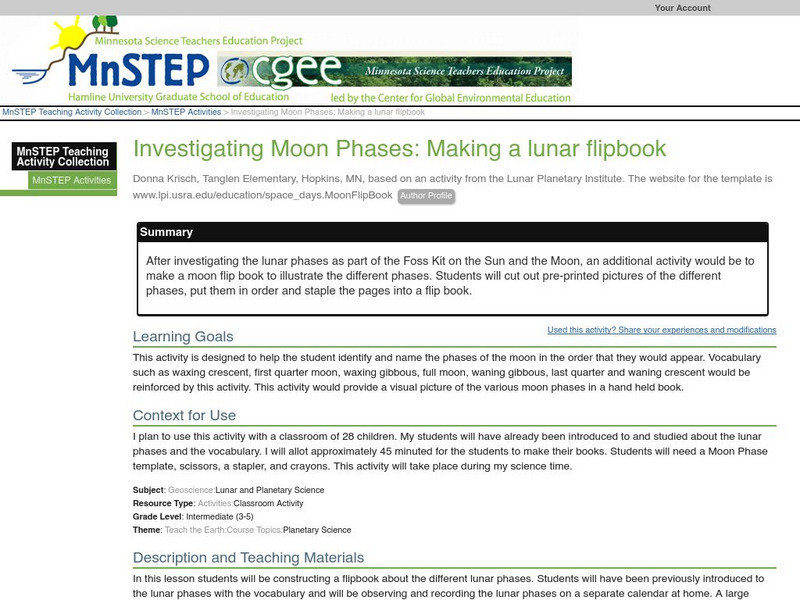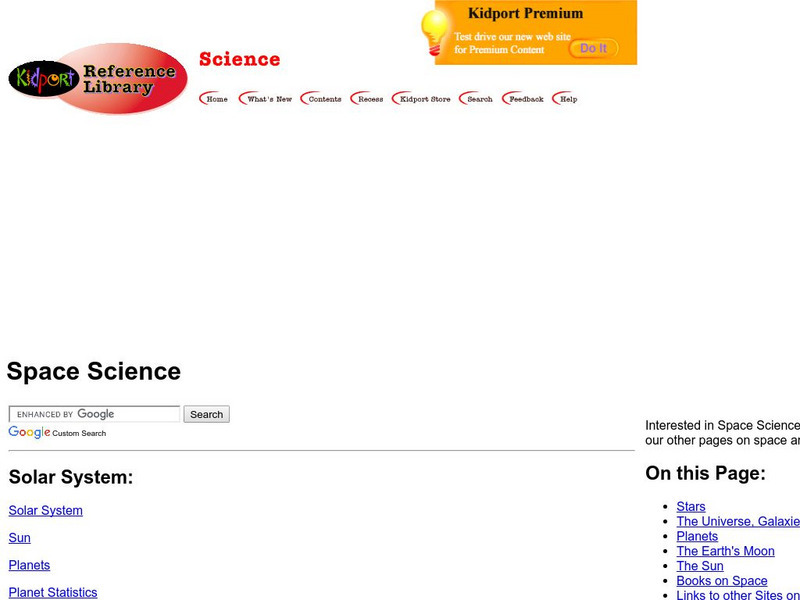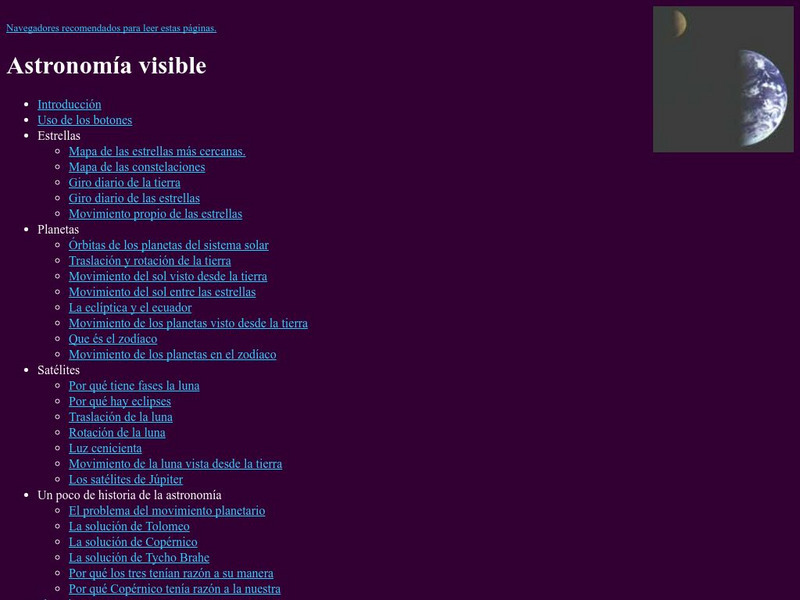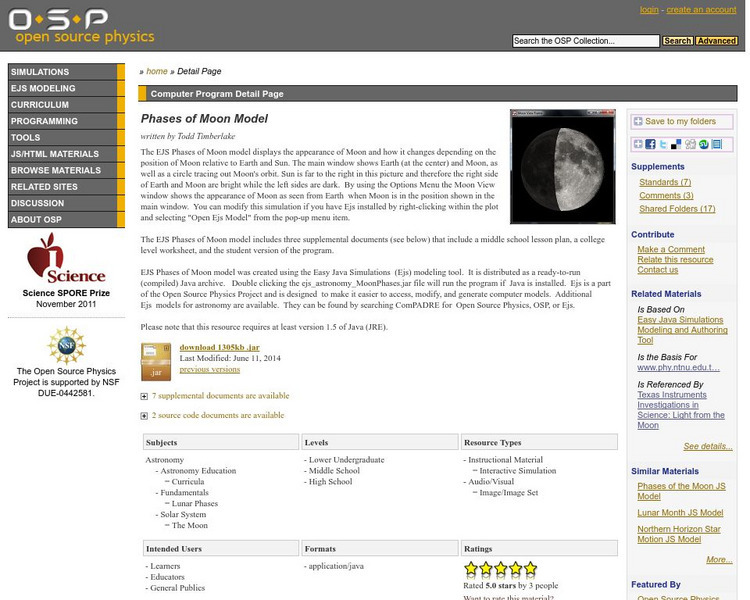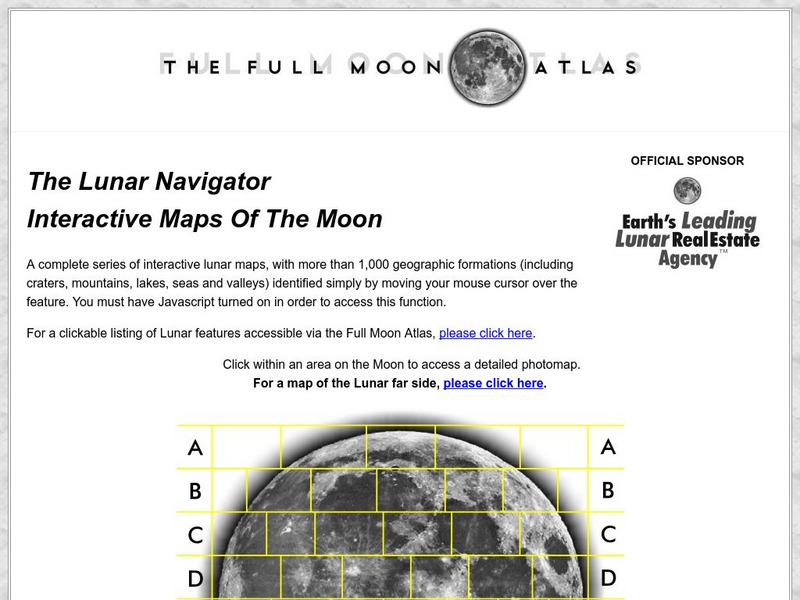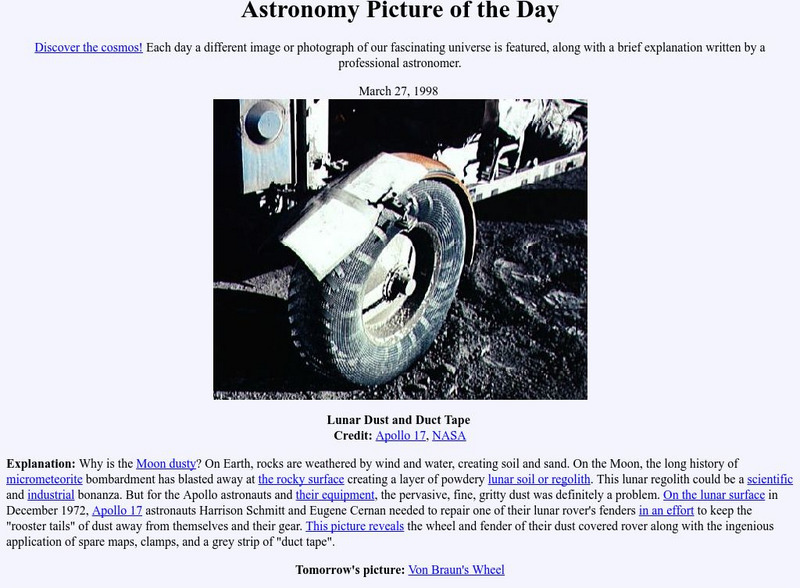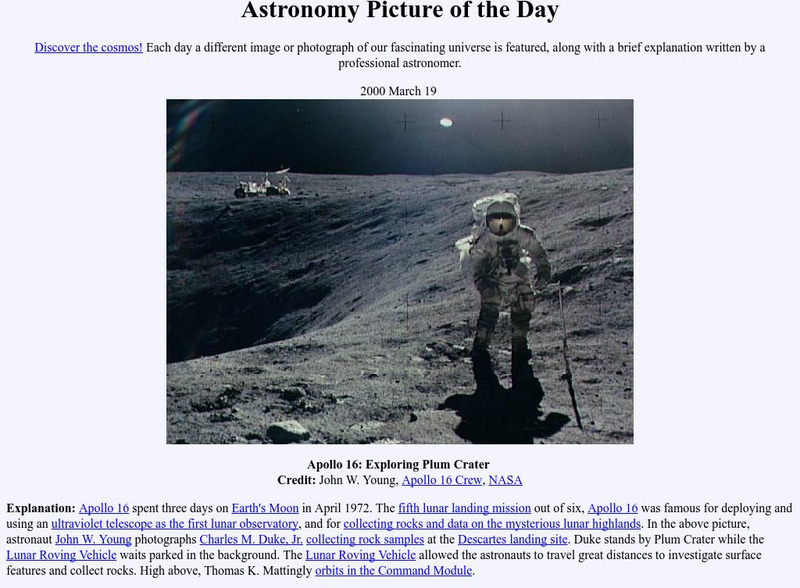University of Oregon
University of Oregon: Io, Moon of Jupiter
Statistics and general information about the volcanic moon of Jupiter. Good comparison, with graphics, of Io's volcanoes and Earthly geysers.
Science Education Resource Center at Carleton College
Serc: Investigating Lunar Phases
In this astronomy classroom activity, learners will investigate how shadows create the phases of the moon. Students will record the phases of the moon.
Science Education Resource Center at Carleton College
Serc: Investigating Moon Phases: Making a Lunar Flipbook
After investigating the lunar phases as part of the Foss Kit on the Sun and the Moon, an additional activity would be to make a moon flip book to illustrate the different phases. Students will cut out pre-printed pictures of the...
Science Education Resource Center at Carleton College
Serc: Experimenting With Angular Diameter and Distance (Study of Outer Space)
In studying the solar system, students compare the relative sizes of the sun and the moon, and experiment with angular diameter, apparent diameter and distance.
Kidport
Kidport: Space Science
This complete resource will help students to improve their understand of space exploration. Includes images of the universe, galaxies, stars and planets.
Ministerio de Educación (Spain)
Observaciones Y Modelos en Astronomia
How does the length of the day change? How does the height of the sun change? Do we always see the same star? The answer to these questions and different observations about the sun, the moon and the stars that we can do from earth can be...
Ministerio de Educación (Spain)
Ministerio De Educacion: Astronomia Para Ninas Y Ninos
Learn basic astronomy and travel through space. After you finish the lessons you can take the evaluation to obtain the clues needed to play the fun space games.
Smithsonian Institution
Smithsonian Learning Lab: The Universe, an Introduction
Start with the questions all students ask: How big is the universe, how far away are the planets and stars, how did they form and when, how do they move and why? Build on their natural curiosity. The Smithsonian, in cooperation with...
Ministerio de Educación (Spain)
Ministerio De Educacion: Astronomia Visible
This site has maps of the nearest stars and constellations. Earth and star daily rotation, proper motion of the stars and many other topics about the solar system are also shown.Read phonetically
Woodlands Junior School
Woodlands Junior School: The Phases of the Moon
This resource provides information about the lunar phases.
American Association of Physics Teachers
Com Padre Digital Library: Open Source Physics: Phases of the Moon Model
Examine the changes that occur with the moon's movement in relationship to the Earth and Sun with this astronomy simulation.
Woods Hole Oceanographic Institution
Whoi: What Causes Tides?
The Woods Hole Oceanographic Institute provides an in-depth but easy to read article on the role of the moon and the sun in respect to tides.
Other
The Full Moon Atlas
Find any location on the moon, including the dark side through this interactive full moon atlas. Click on any segment and mouse over the images to find the names of key geographic features. You can even go to the homepage to translate...
Other
Mas: Lunar Photography With Telephoto Lenses
Ever taken a picture of a nice large full Moon, only to find that it looks like a small dot on your finished photograph? This site explains why, and offers tips on taking good pictures of the Moon.
NASA
Nasa: Central Solar Eclipse Paths: 1991 2050
Resource provides links to maps and path coordinates for every solar eclipse from 1991 through 2050.
NASA
Nasa: The First Lunar Landing
This site from NASA is extensive and contains a deep supply of information about the historical moon landing. Click on "Table of Contents" to proceed through the site. Wonderful images!
Scholastic
Scholastic: Study Jams! Science: Our Solar System: The Moon
A slideshow and a short multiple-choice quiz on the moon. It discusses the moon's phases, its rotation, and characteristics of the moon.
NASA
Nasa: Eye Safety During Solar Eclipses
This resource, which is provided for by NASA, gives great information on protecting your eyes during solar eclipses. Your eyes are very difficult to replace. Even when 99% of the Sun's surface is obscured during the partial phases of a...
Other
Lunar and Planetary Institute: Explore! Marvel Moon
A variety of hands-on activities designed to engage children in learning about the moon.
Other
Lunar and Planetary Institute: Wham! Moon!
In this hour long activity, "children color images of the latest scientific data depicting the Moon's formation to create their own comic strips of our Moon's birth" using a variety of art supplies and books as resources.
NASA
Nasa: Astronomy Picture of the Day: Uranus's Moon Umbriel
Brief overview of Umbriel from NASA. Answers the question "why is the moon so dark"? Provides additional links for more information. A NASA picture of the day.
NASA
Nasa: Astronomy Picture of the Day: Titania, Uranus's Largest Moon
A brief overview of Titania, Uranus's largest moon. Includes a very good description of the moon's surface. A NASA picture of the day.
NASA
Nasa: Astronomy Picture of the Day: Lunar Dust and Duct Tape
Dust, a common and usually minor problem on Earth, presented a major challenge for the Apollo astronauts on the Moon. Here's an interesting solution created by the Apollo 17 crew.
NASA
Nasa: Astronomy Picture of the Day: Apollo 16: Exploring Plum Crater
This is a photograph of Charles M. Duke, Jr. collecting rock samples at the Descartes landing site. Duke stands by Plum Crater while the Lunar Roving Vehicle waits parked in the background. The Lunar Roving Vehicle allowed the astronauts...




